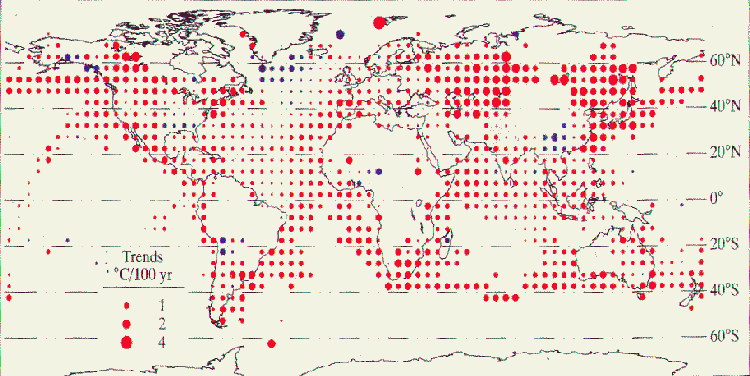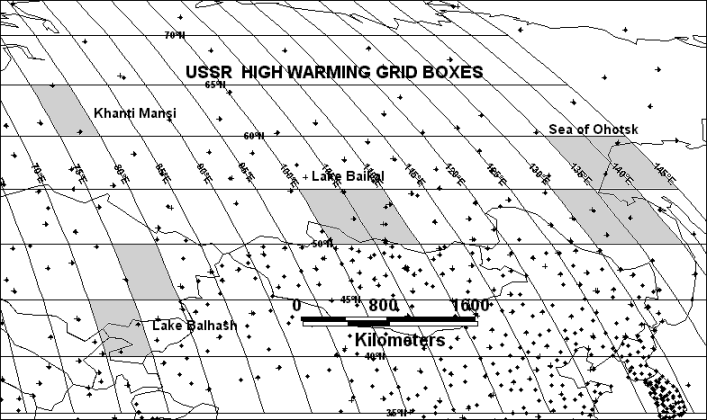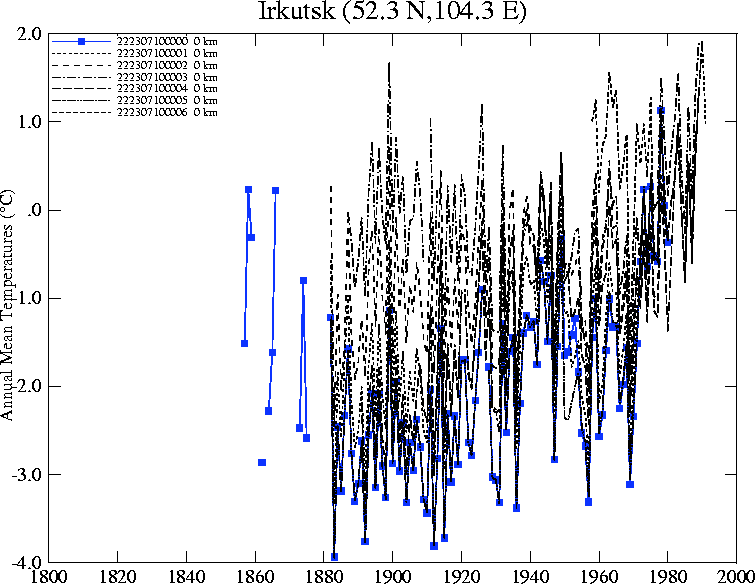
USSR High Magnitude Climate Warming Anomalies 1901-1996
Abstract
Station temperature records are examined in nine five-by-five degree grid cells in the former USSR claimed by Karl 1998 to have warmed by circa 2 degrees over the period 1901-1996. Karl’s results, derived from updated Jones 1994 grid point data, are compared with temperature records from the Jones 1994 global update, the V2 GHCN and the NASA GISS website. In no grid cells are rural station records found to justify the warming claimed in Karl 1998. In three grid cells, stations with warming trends close to the Karl 1998 anomaly magnitudes are found, but in all three cases cities are the source of the apparent warming, which is not apparent at nearby small town or rural stations. The other six grid boxes contain either stations not warming at the rate suggested in Karl 1998, or very incomplete data for the 1901-1996 period. Station-by-station comparisons in all grid boxes show significant trend differences between Jones 1994 and GHCN/GISS data.
Introduction
The veracity of the surface temperature record will continue to be questioned as long as the aggregates used include urban sites, and as long as there is significant departure from lower troposphere temperature trends measured by radiosondes and satellites.
In recent years it has become apparent that a sizeable share
of century-long "global warming" was in the region of
the former USSR. This paper examines at the level of
individual weather station records the evidence for the claim in
Karl 1998 of circa 2 degrees warming during 1901-1996 in nine
grid boxes in Siberia and eastern Kazahkstan. Figure
1 shows the warming over this period from the updated Jones 1994
global dataset as used by Karl 1998 in his contribution to the
IPCC publication "The Regional Impacts of Climate
Change".
Figure 1

The boxes shaded grey in Figure 2 were shown in Karl 1998 as warming by 2 degrees over the indicated period. In this and subsequent figures, crosses indicate Jones 1994 stations, while square diamonds show the Version 2 GHCN stations of Peterson and Vose 1997. The boxes form four zones, reviews of which can be accessed through the following links:
Tarko Sale, Khanty-Mansi Region of Siberia
Far Eastern Siberia, Sea of Ohotsk
Eastern Kazahkstan -
Lake Balkhash
Figure 2

Notes on Data Sources/Temperature Records
The Version 2 Global Historical Climate Network (GHCN) station data (Peterson and Vose 1997) provide the mainstay for this study. These data come from ~7000 stations worldwide, but GHCN mean adjusted data are based on a smaller sample which excludes poorer quality data.
There are 312 stations from the old USSR in the GHCN. It should be noted that the GHCN contains duplicate data for many station names. This is often because separate nearby localities in cities have been archived together. The duplicates are numbered in the GHCN data files starting from 0 (the GHCN preferred version). Version 0 has always been used here. This detail is mentioned because as will be seen in this review, other surveys have accessed different data sources resulting in disparate data choices for the same station. As an example of this, Figure 3, downloaded from the GISS website, shows that 7 sets of widely divergent data are available for Irkutsk.
Figure 3

The Jones 1994 updated data contains just over 3500 stations, more than twice the Jones et al 1991 compilation. In the area of the old USSR, 298 stations are shown, almost as many as in the GHCN.
The NASA GISS website provides a third source of global temperature records. By selecting points on a global map it is possible to view graphs (see Fig. 3) from a range of data types and also to download a table of the station data. GISS data is more processed than the GHCN and has fewer gaps, but the trends are usually similar to the GHCN. The term “gissGHCN” used on chart legends refers to GISS data termed “GHCN Adjusted”. This is the only GISS data used in this study.
Discussion
This study focuses on whether there is any evidence for the
claimed warming from rural stations where data can be
demonstrated to be substantially homogenous with neighbouring
stations. It is interesting that two recent papers by
compilers of global temperature databases, Peterson et al 1999
and Hansen et al 1999, which discuss the V2 GHCN and GISS data
respectively, insist that global trends are little affected
whether one uses rural station data only or mixed city/rural
data. This is not so in these USSR high warming grid boxes,
where cities clearly warm more than rural stations.
The present study also shows that, to a surprisingly large extent, the issue of whether or not the claimed warming is present in these grid boxes depends on which set of station data the reader chooses to rely on. The Jones 1994 data, which also forms the basis for many IPCC presentations, generally warms more than GHCN/GISS data for equivalent stations. The differences between the two sets of data are significant and suggest that at least one is seriously flawed.
Many USSR stations have significant missing data which reduces
the confidence that can be placed in trends.
Summary of Findings
In not one grid box, in any of the datasets, could this survey find in rural records the 1901-1996 warming magnitudes featured in Karl 1998.
In 80% of comparisons the Jones 1994 trends were warmer than GHCN or GISS. The GHCN and GISS trends are generally in fair agreement considering the sparse station density and frequent gaps in data.
In some cases, strong warming trends were based on data from fast-growing cities such as Irkutsk. In view of the well-documented urban heat island effect in such localities, the use of such data to indicate climatic trends lacks credibility.
Data gaps early in the 1901-1996 period, and the increased likelihood of outlier data in pre-1935 records which are hard to check, may have imparted other non-climatic effects on trends.
Despite the central control of the soviet system, the
continuity of meteorological recordings over the period is far
from impressive. It also appears that economic and social
re-adjustments during the 1990's have precluded significant
improvement in record-keeping over this huge land-mass, despite
the sharper focus on climate issues since 1988. Given
the substantial contribution of “Soviet warming” to
“global warming” shown in Fig 1, it is
vital to reassess all of the Soviet station-by-station
records.
References
Goddard Institute for Space Studies (GISS), (2000) Surface Temperature: Station Data. http://www.giss.nasa.gov/data/update/gistemp/station_data
Hansen, JR, Lebedeff S, (1987) Global trends of measured surface temperature. J. Geophysical Research 92:13,345-13,372
Hansen J, Ruedy R, Glascoe, J, Sato, M, (1999) GISS analysis of surface temperature change J. Geophys. Res. 104: 30997-31022.
Jones PD , Raper SCB, Bradley RS, Diaz HF, Kelly PM, Wigley TML. (1986) Northern Hemisphere surface air temperature variations 1851-1984. J. Clim Appl Met. 25:161-179
Jones PD , Raper SCB, Cherry BSG, Goodess CM, Wigley TML, Santer B, Kelly PM, Bradley RS, Diaz HF, . (1991) An Updated Global Grid Point Surface Air Temperature Anomaly Data Set: 1851-1990. Carbon Dioxide Research Program, Environmental Sciences Division, US Department of Energy.
Jones PD, (1994) Hemispheric surface air temperature variations: a reanalysis and an update to 1993. J Clim 7:1794-1802
Karl TR (1998) Annexe A; Regional trends and variations of temperature and precipitation in The regional impacts of climate change, Watson RT, Zinyowera MC, Moss RH (Eds) Cambridge University Press Cambridge
Peterson TC, Vose RS (1997) An overview of the Global Historical Climatology Network temperature database. Bull Amer Met Society 78: 2837-2849
Peterson et al (1999) Global rural temperature trends.
Geophysical Research Letters. Vol 26., No. 3, 328332.
You read it first here
© Warwick Hughes, 2000 - 2001
globalwarming-news.com
Warwick S. Hughes, 22, July, 2000, re-written 24, June, 2001